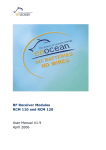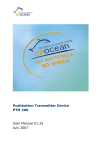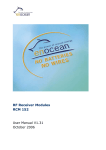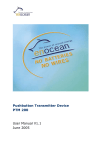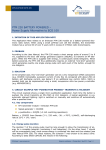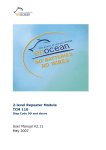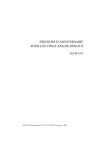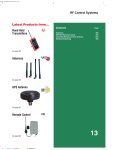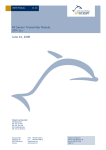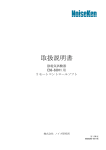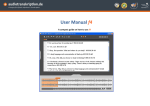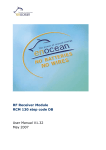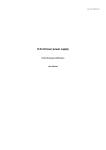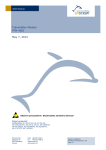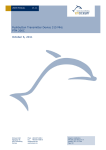Download PTM 200 User Manual
Transcript
Transmitter Module PTM 230 User Manual V1.1 February 2006 Revision History The following major modifications and improvements have been made to the first version of this document (User Manual PTM 230, V1.0): No Major Changes 0.91 0.92 0.93 0.95 0.96 Requirements for energy converter added in 2.1 Section 3.1 Antenna Mounting added Drawing for contact pads added Specification for energy generator modified, tolerance in PCB dimensions modified Minimal switching interval defined in 1.2 and 1.1; change in 2.3.2 maximum 3 subtelegrams are transmitted; hole diameter changed to 2mm in 1.3; antenna end should be insulated in 3.1 Mechanical drawing updated; additional pads for rocker information described; telegram content specified; minimal switching time changed to 50ms. Humidity range reduced to 93% max. Minor changes Editorial changes Energy pulse shape modified 1.0 1.01 1.02 1.03 1.1 Published by EnOcean GmbH, Kolpingring 18a, 82041 Oberhaching, Germany www.enocean.com, [email protected], phone ++49 (89) 6734 6890 © EnOcean GmbH All Rights Reserved Important! This information describes the type of component and shall not be considered as assured characteristics. No responsibility is assumed for possible omissions or inaccuracies. Circuitry and specifications are subject to change without notice. For the latest product specifications, refer to the EnOcean website: http://www.enocean.com. As far as patents or other rights of third parties are concerned, liability is only assumed for modules, not for the described applications, processes and circuits. EnOcean does not assume responsibility for use of modules described and limits its liability to the replacement of modules determined to be defective due to workmanship. Devices or systems containing RF components must meet the essential requirements of the local legal authorities. The modules must not be used in any relation with equipment that supports, directly or indirectly, human health or life or with applications that can result in danger for people, animals or real value. Components of the modules are considered and should be disposed of as hazardous waste. Local government regulations are to be observed. Packing: Please use the recycling operators known to you. By agreement we will take packing material back if it is sorted. You must bear the costs of transport. For packing material that is returned to us unsorted or that we are not obliged to accept, we shall have to invoice you for any costs incurred. ©EnOcean GmbH Page 2 of 12 PTM 230 User Manual V1.1 Table of Contents Revision History _________________________________________________________________________ 2 Table of Contents________________________________________________________________________ 3 1. GENERAL DESCRIPTION________________________________________________________________ 4 1.1 Functional Principle _________________________________________________________________ 4 1.2 Features Overview __________________________________________________________________ 4 1.3 Mechanical Interface________________________________________________________________ 5 1.4 Environmental Conditions __________________________________________________________ 5 1.5 Ordering Information _______________________________________________________________ 5 2. FUNCTIONAL DESCRIPTION ___________________________________________________________ 6 2.1 Block Diagram _______________________________________________________________________ 6 2.2 Pin Description ______________________________________________________________________ 6 2.3 PTM 230 Radio Telegram ___________________________________________________________ 7 3. APPLICATIONS INFORMATION ________________________________________________________ 9 3.1 Antenna Mounting___________________________________________________________________ 9 3.2 Transmission Range _______________________________________________________________ 10 3.3 Approval Requirements ____________________________________________________________ 10 4. DEVELOPMENT TOOLS _________________________________________________________________ 11 4.1 Evaluation Kit EVA 100 ____________________________________________________________ 11 4.2 On-board Overview EVA-PCB ______________________________________________________ 11 4.3 EVA 100 Scope of Supply and Ordering Information _____________________________ 11 5. DECLARATION OF CONFORMITY ______________________________________________________ 12 ©EnOcean GmbH Page 3 of 12 PTM 230 User Manual V1.1 1. GENERAL DESCRIPTION The radio transmitter module PTM 230 from EnOcean enables the implementation of batteryless radio switches for applications in e.g. building technology or industrial automation. Power is provided by an external electrodynamic power generator such as ECO 100 or a short energy pulse. The PTM 230 module serves the 868 MHz air interface protocol of EnOcean. Together with the receiver module RCM 120, this module can be easily integrated in operation and control units for the implementation of different application-specific system solutions. 1.1 Functional Principle When a short energy pulse is supplied to the PTM 230 module an RF telegram is transmitted including a 32-bit module ID and the polarity of the supply voltage. In addition the information of 2 inputs is transmitted. With the 2 inputs one rocker of a PTM 200 can be simulated. 1.2 Features Overview Power supply: ........................... external electro-dynamic power generator or energy pulse Frequency:...................................................................................................868.3 MHz Transmission power:.................................................................................max. 10 mW Modulation type: ...................................................................................................ASK Data rate: ......................................................................................................120 kbps Channel bandwidth: ........................................................................................ 280 kHz Minimal switching interval: ............................................................................... 45 ms Antenna:.............................................. λ/4-whip antenna mountable, no antenna mounted Transmission range: .................... approx. 300 m free field, 10m in industrial environment (range strongly dependent on surrounding material and position relative to energy harvester or other metal surfaces) Serial Telegram type (RCM120): .............................................................RPS of type 2 Module identifier: ............................................ individual 32-bit ID (factory programmed) Radio standards: ......................................... R&TTE 1999/5/EC, ETSI EN 300220-3 V1.1.1 EMC standards: .............................. 89/336/EC, 92/31/EWG, EN 61000-6-2, EN 61000-6-4 .....................................................................EN 301489-01 V1.5.1 , EN301489-03 V1.4.1 ©EnOcean GmbH Page 4 of 12 PTM 230 User Manual V1.1 1.3 Mechanical Interface PWR2 PWR1 Figure: PCB Dimensions in mm (view on pads) 1.4 Environmental Conditions Operating temperature: ..................................................................... -25 up to +65 °C Storage temperature: ........................................................................ -40 up to +85 °C Humidity:................................................... 0 % to 93 % r.h., non-condensing, no IP-class 1.5 Ordering Information Type EnOcean Ordering Code PTM 230 S3011-A230 ©EnOcean GmbH Page 5 of 12 PTM 230 User Manual V1.1 2. FUNCTIONAL DESCRIPTION 2.1 Block Diagram Data SW1 Processor Vcc HF SW2 ANT Polarity DC Power PWR 1 PWR 2 Power Converter Figure: Block diagram of PTM 230 2.2 Pin Description Symbol PWR1, PWR2 Function Inputs for EnOcean energy Operational characteristics Maximum wire length to energy converter: 5cm each converter ECO 50 or ECO 100 or equivalent energy pulse Requirements for energy pulse: • EPulse > 0.45mWs • 2.5V ≤ Umax,Pulse ≤ 5.5V • 0,001ms ≤ TPulse ≤ 11ms (voltage measured with module connected; required pulse width depends on voltage, pulse shape and source impedance) SW1, SW2 Vcc ANT ©EnOcean GmbH Digital inputs for simulation of O-button and I-button signal of a PTM 200 Connect SW1 to Vcc for simulation of “I-button” Connect SW2 to Vcc for simulation of “O-button” Supply for SW1 and SW2 Pad for antenna mounting Maximum wire length to Vcc: 3cm each The signal at SW1 and SW2 must be available > 100µs before and > 10ms after energy is supplied to the module. Maximum wire length to SW1, SW2: 3cm 87mm whip antenna as defined in 3.1 Antenna Mounting Page 6 of 12 PTM 230 User Manual V1.1 2.3 PTM 230 Radio Telegram 2.3.1 Frequency range and transmission cycle allowed The EnOcean technology operates the 868.3 MHz radio channel, which is exclusively released for short-time data transmission in Europe. All transmitters have to stick to a duty cycle of max. 1% within one hour. Permanent transmitters such as radio earphones are not allowed. For conventional applications, it must be ensured that the PTM 230 radio module is not operated more than 15000 times within one hour (one operation: button is pressed and released). Within this calculation, the extraordinary short telegram length is considered including three subtelegrams (see Chapter 2.2.3). 2.3.2 Modulation process As modulation process, EnOcean uses incoherent amplitude modulation (ASK). Digital amplitude modulation enables the implementation of very efficient energy-saving transmitters because only the “1”-bits are transferred. At the same interference signal level, the transmission security of the alternative FSK method is identical to that of the ASK method (Reference: Pehl, Digitale und analoge Nachrichtenübertragung, Hüthig 2001). 2.3.3 Transmission timing The transmission timing of the radio module PTM 230 has been developed to avoid possible collisions with data packages of other EnOcean transmitters as well as disturbances from the environment. With each transmission cycle, three identical subtelegrams are transmitted. The transmission of a subtelegram lasts approximately 0.7 ms. To optimize data security, each telegram is repeated twice within about 20 ms, whereas the delay between the second and the third transmission burst is effected at random. Figure: PTM 230 radio timing ©EnOcean GmbH Page 7 of 12 PTM 230 User Manual V1.1 2.3.4 Telegram Data The PTM 230 transmits an EnOcean radio telegram which is provided at the serial output of a RCM 120 or TCM 120 module with the following parameters: Unique factory programmed 32bit ID Data2, Data1, Data0=0 Data3 and Status as follows: SW1 open Vcc open Vcc SW2 open open Vcc Vcc ORG 0x05 0x05 0x05 0x05 Data3 000PXXXX 000P0000 001P0000 001P0001 Status XX10RRRR XX11RRRR XX11RRRR XX11RRRR P=polarity, X=reserved, R=repeater counter The polarity P is defined as follows: PWR1 + - ©EnOcean GmbH PWR2 + P 1 0 Page 8 of 12 PTM 230 User Manual V1.1 3. APPLICATIONS INFORMATION 3.1 Antenna Mounting Positioning and choice of receiver and transmitter antennas are the most important factors in determining system transmission range. The PTM 230 modules are supplied without antenna. For standard applications the use of a whip antenna is recommended (87 mm/ 0.14 mm2 Cuwire). This antenna enables very compact unit with good radio characteristics. For mounting the antenna, the following notes should be considered to optimize the system performance: Mounting a 1/4-wave whip antenna: For good transmit performance, great care must be taken about the space immediately around the antenna since this has a strong influence on screening and detuning the antenna. The antenna should be drawn out as far as possible and must never be cut off. Primarily, the far end of the wire should be mounted as far away as possible from all metal parts, PCB strip lines and fast logic components (e.g. microprocessors). To avoid radio frequency hash from the motherboard, which desensitizes the unit, PCB strip lines on the motherboard should be designed as short as possible, and using PCB ground plane layer is also recommended. To avoid possible damage to the module the end of the antenna should be insulated. Note that 868 MHz whip antennas do not show any directional effects under free-field radiowave propagation conditions (spot-wise radiator). (tinned) bared, twisted and tinned Cu-wire, 0.14 mm2 cross section according to VDE 0812 or 0245 Cl.5 or Cl. 6 TI2, according Insulation:PVC Isolation: PVCmixture mixtureTI2, to VDE 0207-4 Figure: Specification of whip antenna ©EnOcean GmbH Page 9 of 12 PTM 230 User Manual V1.1 3.2 Transmission Range The main factors that influence the system transmission range are type and location of the antennas of the receiver and the transmitter, type of terrain and degree of obstruction of the link path, sources of interference affecting the receiver, and “dead” spots caused by signal reflections from nearby conductive objects. Since the expected transmission range strongly depends on these system conditions, range tests should categorically be performed before notification of a particular range that will be attainable by a particular application. The following figures for expected transmission range are considered by using the PTM 100 radio transmitter module and the RCM 110 or RCM 120 radio receiver module with the preinstalled whip antennas and may be used as a rough guide only: • 10 m in industrial applications with metal in the vicinity • 30 m for obstructed environment (e.g., through two brick walls inside a building) • 300 m for unobstructed environment (“free field”) Further notes to determine the transmission range within buildings are available as download from www.enocean.com. 3.3 Approval Requirements The modules bear the EC conformity marking CE and conform to the R&TTE EU-directive on radio equipment. The assembly conforms to the European and national requirements of electromagnetic compatibility. The conformity has been proven and the corresponding documentation has been deposited at EnOcean. The modules can be operated without notification and free of charge in the area of the European Union, in Switzerland, in Cyprus, in Czech, in Estonia, in Hungary, in Latvia, in Lithuania, in Malta, in Poland, in Romania and in Slovenia. The following provisos apply: • EnOcean RF modules must not be modified or used outside their specification limits. • EnOcean RF modules may only be used to transfer digital or digitized data. Analog speech and/or music are not permitted. • The final product incorporating EnOcean RF modules must itself meet the essential requirement of the R&TTE Directive and a CE marking must be affixed on the final product and on the sales packaging each. Operating instructions containing a Declaration of Conformity has to be attached. • If transmitters are used according to the regulations of the 868.3 MHz band, a so-called “Duty Cycle” of 1% per hour for each transmitter must not be exceeded (also see Chapter 2.3.1). ©EnOcean GmbH Page 10 of 12 PTM 230 User Manual V1.1 4. DEVELOPMENT TOOLS 4.1 Evaluation Kit EVA 100 EVA 100 is an evaluation kit to support a simple setting-up operation of the receiver side when the EnOcean transmitter module PTM 230 is evaluated. EVA 100 supports a quick evaluation of all RCM 110 and RCM 120 receiver operation modes and supports the fast development of applications. 4.2 On-board Overview EVA-PCB Symbol Adaptor RCM 100 Test Connector Vcc GND GND R0 R1 R2 R3 GND EVG GND PWM RS232 Function Female jack for power supply Female header for plug-in RCM 110 or RCM 120 module Female header connected directly to RCM leads Jack to disconnect RCM power supply Ground connector for control outputs Functional control outputs. Also indicate current learning mode status. R0..3 are directly connected to the OUT_0..3 output pins of RCM 110/120 module Analog output to drive an Electronic Control Gear 50 kHz PWM output DB9 female connector 4.3 EVA 100 Scope of Supply and Ordering Information Type EVA 100 ©EnOcean GmbH EnOcean Ordering Code H3004-G100 Scope of supply • Evaluation Board EVA-PCB • EnOcean radio modules PTM 100 (incl. Rocker Model), STM 100, RCM 110 and RCM 120 • CD with PC-link Monitor Software and detailed kit documentation • Wall power supply for EVA-PCB • Convenient equipment case Page 11 of 12 PTM 230 User Manual V1.1 5. DECLARATION OF CONFORMITY Will be available with PTM 230 series release ©EnOcean GmbH Page 12 of 12 PTM 230 User Manual V1.1












